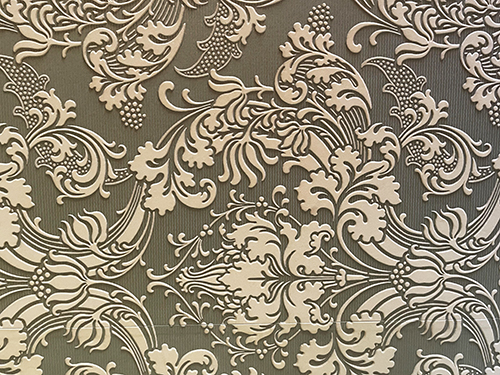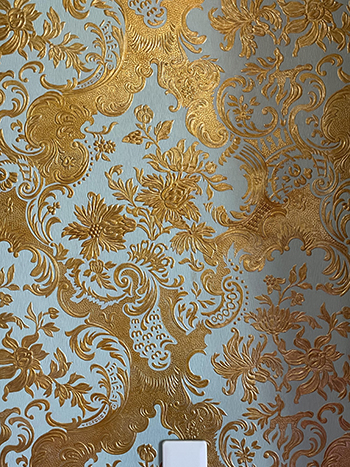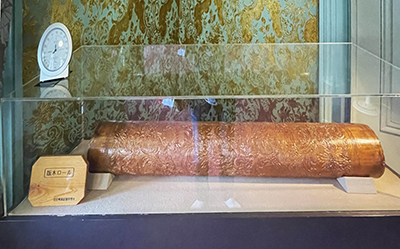


さてきのうは、明治期ニッポンの旺盛な西洋文明受容ぶりに着目したけれど、もう一方で、旧岩崎邸には明治の職人魂、日本のものづくりの痕跡も刻印されている。
壁紙という文化は江戸期までの日本住宅文化では、茶室などでの壁面下部に使い古しの和紙、多くは手紙などがそのまま張られる事がある程度。なんですが、あれはあれで非常に面白い日本文化だと思っています。実用としては茶室に座ったときに、着衣が塗り壁に直接触れてこすれることを防止する役割だったと思うのですが、まことに日本人らしい実用性と、茶室での会話の切り口として、亭主のセンスも表現していたのだろうと思える。まことに茶亭での会話にふさわしそう。
で、こちらの旧岩崎邸では、基本デザインは「洋館」であり英国人建築家による空間イマジネーションになるものですが「壁紙」が各室毎に違いがあって特徴的な空間性を醸し出している。
で、2階の解説コーナーで、説明が加えられていた。
〜この旧岩崎邸では壁紙として「金唐革紙ーきんからかわし」が使われている。これは江戸期にオランダとの貿易で交易船がもたらした金唐革を和紙で模造加工した「擬革紙」の一種です。17世紀後半期に袋物用として渋紙あるいは油紙を活用した小判の擬革紙つくりがはじまり、江戸末期には浮き凸模様を打ち出して、顔料・油・漆・金属箔などで高度に装飾加工したものが作られるようになっています。
そして明治初期には壁装用として大判の擬革紙を創製して明治6年のウィーン万国博覧会に「金革壁紙」として出展。海外輸出の道が開かれました。昭和初期から「金革革紙」の名前が定着した。いずれにしてもメイドインジャパンの当時最高の加工技術を施した和紙工芸品であり、東西文化交流を象徴する文物といえるでしょう。〜

革紙というのは、動物皮革で壁面を装飾するものとされる。わたし自身はそういう実物建築例を見たことはない。「革紙」というコトバでググっても「擬革紙」と自動変換されてその情報しか得られないほどに、希少例なのだろうと思います。しかし江戸期の交易で得られた実物を見ながら、それを和紙で変換してあらたな製品を生み出していく江戸期日本のものづくり魂は素晴らしい。
そしてそういう壁紙技術に着目した英国人建築家コンドルは、この極東の最高級住宅建築に、各室毎に違うデザインの壁紙として採用させている。1896年建築のこの邸宅で、すでに日本のものづくりの実力にリスペクトしてくれたコンドルの審美眼に感謝したくなる。いや、コンドルはこうした日本の技術に魅了され世界最高品質と認めて、ごく自然に利活用したのだろうか。
圧倒的な西洋文化の移植の明治期にあっても、優れた日本の職人技術はすでに世界レベルを超えるものが数多くあったということなのだろう。深く頭が下がる思い。
English version⬇
Kinkarakawakami / Japanese Domestic Wallpaper Technology: A Visit to the Former Iwasaki Residence-6
Inspired by animal hide leather paper traded with the Dutch during the Edo period, Japanese craftsmen created “imitation leather paper” using Japanese paper, which drew the respect of the English architect Conder. The…
Yesterday, I focused on Japan’s vigorous acceptance of Western civilization during the Meiji period, but on the other hand, the former Iwasaki residence also bears traces of Meiji-era craftsmanship and Japanese manufacturing.
In the Japanese residential culture until the Edo period, wallpaper was used in tea ceremony rooms and other places where used Japanese paper, often letters, were stretched over the lower part of the wall. I think this is a very interesting aspect of Japanese culture. I think that the practical purpose was to prevent the clothes from rubbing directly against the painted walls when sitting in the tea room, but I think that it had a very Japanese practicality and also expressed the sense of the owner as an opening for conversation in the tea room. It seems to be a very appropriate for a conversation at a tea ceremony house.
The basic design of the former Iwasaki Residence is a “Western-style house,” and the space was imagined by a British architect, but the wallpaper in each room is different, creating a distinctive spatiality.
The wallpaper is different in each room, creating a distinctive spatial effect.
〜The wallpaper used in the former Iwasaki Residence is “Kin Karakawashi” (gold-embossed paper). In the latter half of the 17th century, the production of imitation koban leather paper began using astringent or oiled paper for bags, and by the end of the Edo period, highly decorated paper with raised and convex patterns was produced using pigments, oil, lacquer, metal foil, and other materials. By the end of the Edo period, koban fukigami was being made with raised and convex patterns and highly decorated with pigments, oil, lacquer, and metal foil.
In the early Meiji period (1868-1912), large-size imitation leather paper was created for wall coverings and exhibited as “gold-leather wallpaper” at the Vienna World Exposition in 1873. This opened the way for overseas exports. Since the early Showa period, the name “gold-leather leather paper” has been established. In any case, it is a Japanese paper craft product made in Japan with the best processing technology of the time, and is a cultural artifact that symbolizes the cultural exchange between East and West. ~ (Japanese only)
Leather paper is a type of wall decoration made of animal hides. I myself have never seen such an actual architectural example. I think it is so rare that even if you Google the word “kakawakami,” it is automatically converted to “pseudo-hide paper,” and that is all the information you can get. However, it is wonderful to see the spirit of Japanese craftsmanship during the Edo period, which saw actual products obtained through trade and converted them into new products using washi paper.
It is a great honor for the British architect Condor to have such wallpaper technology used in the Far East’s finest residential buildings, with each room having a different wallpaper design, and we should be grateful to his aesthetic eye for respecting Japanese craftsmanship in this 1896 residence. Or perhaps Condor was fascinated by such Japanese technology, recognized it as the highest quality in the world, and utilized it very naturally.
Even during the Meiji period, when Western culture was overwhelmingly transplanted to Japan, there were already many excellent Japanese craftsmen’s techniques that exceeded the world’s level. I am deeply humbled.
Posted on 9月 8th, 2023 by 三木 奎吾
Filed under: 住宅マーケティング, 住宅性能・設備







コメントを投稿
「※誹謗中傷や、悪意のある書き込み、営利目的などのコメントを防ぐために、投稿された全てのコメントは一時的に保留されますのでご了承ください。」
You must be logged in to post a comment.